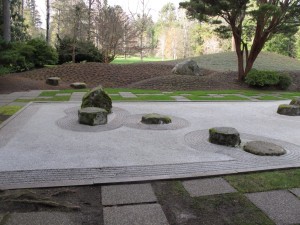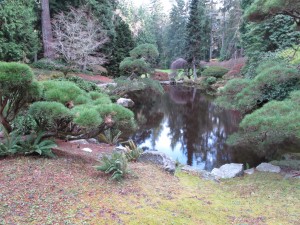Japanese Gardens
I recently visited an old college friend in Seattle, Washington and while out there we went to some nice gardens in the area. The Bloedel Reserve is on Bainbridge Island, a 30 minute ferry ride from downtown Seattle. It is a private 150-acre estate that was once the summer home and gardens of a wealthy Seattle family. The founder’s vision was “to provide refreshment and tranquility in the presence of natural beauty,”; the Reserve’s mission is to “enrich people’s lives through a premier public garden of natural and designed Pacific Northwest landscapes.”In my opinion, it meets its goals well.
The best part of the Bloedel Reserve, for me, is the Japanese garden. I have visited several Japanese gardens, and this one is a fine example of the style. It includes a tea house, a dry garden, a small flowing brook that enters a nice pond, large stones, lovely trees and flowers in season. Although I don’t aspire to create a Japanese garden, I recognize that many of the elements that are so attractive in a Japanese garden can be utilized in my own garden – or perhaps yours.
On the surface, at least, the easiest part of the Japanese garden is the dry garden, also called the flat garden or hira-niwa. Generally in Japanese gardens this is a space without vegetation: raked sand or fine gravel that is interspersed with stones of various sizes and shapes. To me, the fine gravel represents the sea and the large stones in it, islands. Some Japanese gardens include trees on islands in the dry garden, but this one did not. At Bloedel Reserve, the shape of the dry garden was rectangular, though I have to say I prefer the curves of others I have seen – they seem more natural. It is traditional to rake the sand or gravel regularly to create interesting patterns in it.
If I were to create a dry garden, I would certainly install a weed barrier beneath the gravel. I wouldn’t use plain black plastic – as effective as it is in keeping out weeds – as it would hold water. There are a variety of woven weed barriers that allow moisture to pass through, although some grasses and weeds can send roots through them. It’s important to have the dry garden flat.
It would be essential to have some kind of edging to keep grasses from creeping into the dry garden. Plastic edging exists in various forms – rolls, sections that interlock – but I have never found them easy to install or very effective at keeping out grasses. I like the “professional” edging made of steel or aluminum that comes in 10-foot sections and is held in place with metal pegs. It generally comes with a black painted surface. It is quite flexible, allowing one to create smooth curves, and can be installed using an edging tool or spade to cut through sod. Stone pavers would also work nicely.
Traditionally there is a tea house that overlooks the dry garden, and Bloedel was no exception. This is a place to sit and reflect on the tranquility of the gardens. The tea house has large glass panels on the side facing the dry garden, which create a visual frame for the dry garden from inside.
There are also benches throughout the gardens where one can sit and observe or ponder the state of the world. I think sitting places are important for any garden, the more comfortable the better. I have two stone benches in my gardens, but rarely sit on them for long – the stone is hard and often cold. But wooden ones, or wooden chairs, are more comfortable. And now days brightly colored Adirondack chairs in recycled plastic are not only comfortable, they are inexpensive – but not very Japanese.
Water is an important element of a Japanese garden, and traditionally they have both streams and ponds. The technology exists to create re-circulating streams and waterfalls, or to install a nice small plastic-lined pool. Goldfish or koi are an important element to small manmade pools, as they help to keep the water clean. At Bloedel a dry stream was created using stones “flowing” down a hillside.
The vegetation of any Japanese garden is important, too. Japanese red maples (Acer palmatum), rhododendrons, cherry trees and various evergreens, (particularly weeping evergreens) are commonly used for vertical elements. Weeping red maples stay small and can be very effective in Japanese gardens, but often are not hardy in Zones 3 and 4.
At Bloedel the perennial plants were largely dormant in late November, but I recognized the leaves of hellebores, decorative grasses, ferns, mosses and groundcovers.
It’s good, I think, to dream of garden projects, especially in these dark days of December. And who knows? Maybe I’ll decide to create a small Japanese garden next summer – but if you do, let me know as I’d love to visit it.
Henry Homeyer can be reached at P.O. Box 364, Cornish Flat, NH 03746 or henry.homeyer@comcast.net. His Web site is www.Gardening-guy.com.




